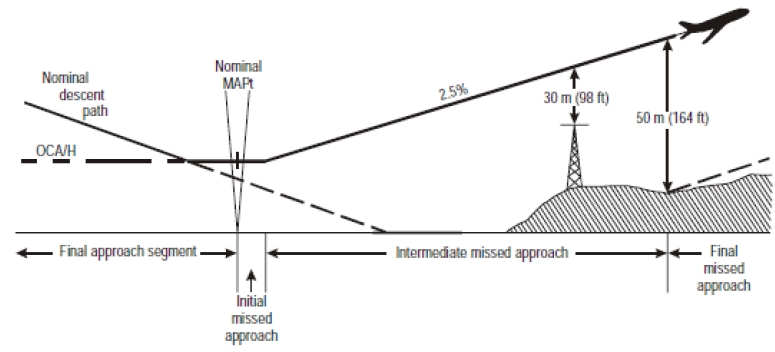¶ Introduction
A missed approach segment must be followed if the approach cannot be continued. In this segment, the pilot is faced with the demanding task of changing the aircraft configuration, attitude and altitude.
The missed approach should be initiated not lower than the decision altitude/height (DA/H) in precision approach procedures, or at a specified point in non-precision approach procedures not lower than the minimum descent altitude/height (MDA/H).
It is expected that the pilot will fly the missed approach procedure as published.
The design of the missed approach consists of the three phases:
- Initial
- Intermediate
- Final

¶ Missed approach point (MAPt)
Only 1 missed approach procedure is established for each instrument approach procedure. It is designed to provide protection from obstacles throughout the missed approach manoeuvre. It specifies a point where the missed approach begins and a point or an altitude/height where is ends.
The MAPt in a procedure may be defined by:
- The point of intersection of an electronic glide path with the applicable DA/H in APV or precision approaches
- A navigation facility, a fix or a specified distance from the final approach fix in non-precision approach
The missed approach shall be initiated when reaching the MAPt.
If a missed approach is initiated before arriving at the missed approach point (MAPt), the pilot will normally proceed to:
- The MAPt (any turns on the missed approach shall not begin until the aircraft reaches the MAPt).
- The middle marker fix or a specified DME distance for precision approach procedures.
When approaching the DA/H or MDA/H, only one of the 2 options exists for the crew:
- Continue the descent below DA/H or MDA/H to land with the required visual reference in sight
- Execute a missed approach.
If the visual references required to land have not been acquired when the aircraft is approaching the MDA/H, the vertical (climbing) portion of the missed approach is initiated at an altitude above the MDA/H sufficient to prevent the aircraft from descending through the MDA/H.
If the visual conditions are adequate, the aircraft continues the descent to the runway.
¶ Missed approach gradient
The nominal missed approach climb gradient is 2.5%. Gradients of 3%, 4% or 5% may be used for aircraft of which the climb performance permits an operational advantage to be thus obtained and this is indicated on the instrument approach chart. A gradient of 2% may be used if necessary survey and safeguarding have been provided.
Special conditions: The operation of aircraft, when operating at or near maximum certificated gross mass and with engine-out conditions, needs special consideration at aerodromes which are critical due to obstacles on the missed approach area. This may result in a special procedure being established with a possible increase in the DA/H or MDA/H.
¶ Initial phase
The initial phase of a missed approach begins at the MAPt and ends at the start of climb. This phase is critical for a pilot and needs attention on establishing the changes in aircraft configuration and starting the climb. No turns are specified in this phase.
¶ Intermediate phase
The intermediate phase of a missed approach begins at the start of climb. The climb is continued normally straight ahead. It extends to the first point where 50m (164ft) obstacle clearance is obtained and can be maintained.
The intermediate missed approach track may be changed by a maximum of 15°. During this phase, it is assumed that the aircraft begins track corrections.
¶ Final phase
The final phase begins at the point where 50m (164ft) obstacle clearance is first obtained and can be maintained (40m (131ft) for category H). It extends to the point where a new approach, holding or a return to en-route is initiated.
¶ Restrictions
Where an obstacle is located early in the missed approach procedure, the instrument approach chart is annotated:
- "Missed approach turn limited to 'value' KT IAS maximum"
- "Missed approach turn as soon as practicable to 'value' heading"
The following parameters are specific to turning missed approach:
- Bank angle = 15°
- Wind = 95% of probability on an omnidirectional basis (or 30KT where no data is available)
- Speed = missed approach range speed in the table chapter 4.
- Pilot reaction time = up to 3 seconds.
- Bank establishment time = up to 3 seconds.
- ICAO Documentation 8168 - Aircraft Operations - Volume I - Flight Procedures - 6th Edition 2010 - Section 4 - Chapter 6
- VID 150259 - Creation
- VID 531824 - Wiki Integration
- VID 496402 - Wiki.js integration